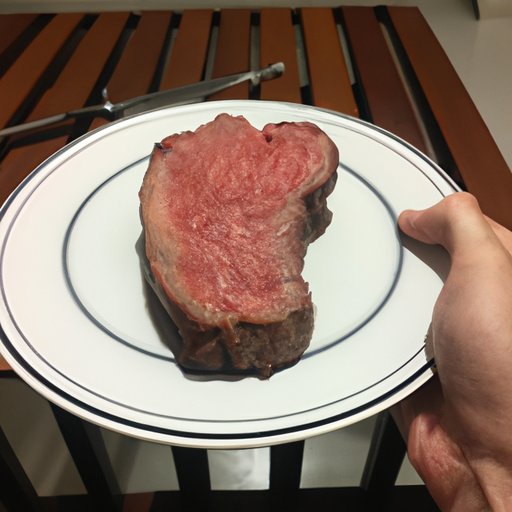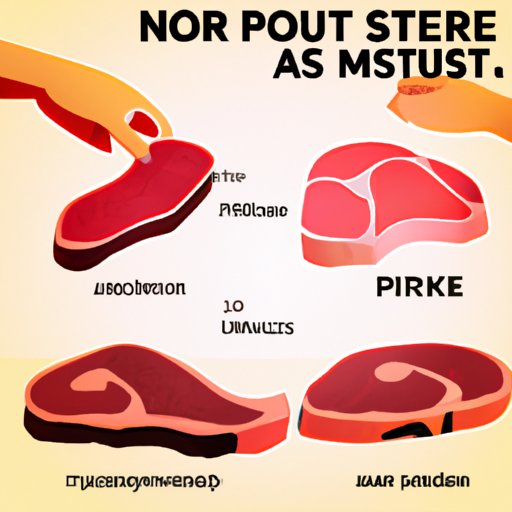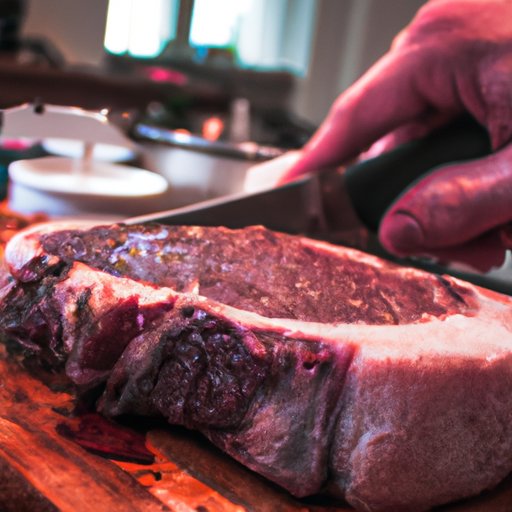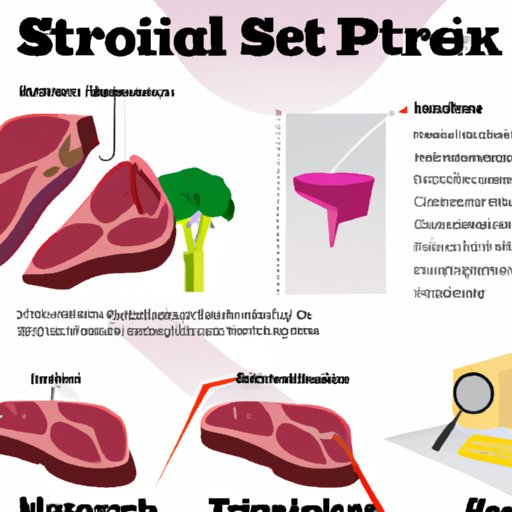Introduction
Sirloin steak is a lean cut of beef that is prized for its rich flavor and tender texture. It is also an excellent source of protein, iron, zinc, and other essential nutrients. In this article, we’ll explore the nutritional benefits of sirloin steak, as well as the pros and cons of eating it. We’ll also provide tips for choosing a healthy cut and incorporating sirloin steak into a balanced diet.

Exploring the Nutritional Benefits of Sirloin Steak
When it comes to nutrition, sirloin steak offers several key benefits. It is a good source of protein, which is essential for building and maintaining muscle mass, and it is relatively low in fat. As registered dietitian Sharon Palmer notes, “The sirloin has a great balance of protein and fat. It’s a leaner cut than ribeye or New York strip, but still contains enough fat to make it flavorful.”
Let’s take a closer look at the nutritional profile of sirloin steak:
Protein Content
Sirloin steak is a good source of protein. A 3-ounce serving of cooked sirloin steak provides about 20 grams of protein, which is roughly 40 percent of the recommended daily intake for adults. Protein is essential for building and maintaining muscle mass, and it can also help you feel fuller for longer.
Fat Content
Sirloin steak is relatively low in fat. A 3-ounce serving of cooked sirloin steak contains about 5 grams of total fat, of which 2 grams are saturated fat. Saturated fat is associated with an increased risk of heart disease, so it’s important to limit your intake. However, sirloin steak is also a good source of monounsaturated fat, which may help lower cholesterol levels.
Vitamin and Mineral Content
Sirloin steak is also a good source of several vitamins and minerals. It is especially rich in iron, zinc, and B vitamins. Iron helps transport oxygen throughout the body, while zinc plays a role in immune function and wound healing. The B vitamins are essential for energy production, and they may also help reduce the risk of certain diseases.
How to Choose a Healthy Cut of Sirloin Steak
When shopping for sirloin steak, it’s important to choose wisely. Here are some tips for selecting a healthy cut:
Look for Lean Cuts
When shopping for sirloin steak, look for cuts that are labeled as “lean” or “extra lean.” These cuts are typically lower in fat and calories. For example, a 3-ounce serving of extra lean sirloin steak contains about 3.5 grams of fat and just 140 calories.
Trim Away Visible Fat
Before cooking sirloin steak, be sure to trim away any visible fat. This will help reduce the amount of saturated fat in the meal. You can also ask your butcher to do this for you.
Avoid Processed Sirloin Steaks
It’s best to avoid processed sirloin steaks, such as pre-packaged marinated steaks or steak strips. These products often contain added sugar, sodium, and unhealthy fats, which can negate the health benefits of sirloin steak.
A Dietitian’s Guide to Eating Sirloin Steak
Eating sirloin steak can be part of a healthy diet, as long as it is consumed in moderation. Here are some tips for incorporating sirloin steak into a healthy diet:
Tips for Incorporating Sirloin Steak into a Healthy Diet
• Choose lean cuts of sirloin steak and trim away visible fat before cooking.
• Limit your portion size to 3 ounces per serving.
• Avoid processed sirloin steaks, such as pre-packaged marinated steaks or steak strips.
• Balance your meals by including plenty of vegetables and whole grains.
• Make sirloin steak an occasional treat rather than a regular part of your diet.
Making Smart Side Dish Choices
When enjoying sirloin steak, choose healthy side dishes to round out the meal. Try roasted vegetables, a side salad, or a quinoa pilaf. These sides are much lower in fat and calories than traditional accompaniments like french fries or mashed potatoes.
Moderation is Key
Eating sirloin steak in moderation is key to maintaining a healthy diet. Registered dietitian Ashley Koff recommends limiting red meat to no more than three servings per week. If you’re looking for a protein-rich alternative to sirloin steak, consider incorporating poultry, fish, beans, or tofu into your meals.
The Pros and Cons of Eating Sirloin Steak
Let’s take a look at the pros and cons of eating sirloin steak:
Pros
• High in protein: Sirloin steak is a good source of protein, which is essential for building and maintaining muscle mass.
• Low in fat: Sirloin steak is relatively low in fat, especially when compared to other cuts of beef.
• Versatile: Sirloin steak can be grilled, baked, sautéed, or stir-fried, making it a versatile option for any meal.
Cons
• High in cholesterol: Sirloin steak is high in cholesterol, so it should be enjoyed in moderation.
• High in saturated fat: Sirloin steak is also high in saturated fat, which is associated with an increased risk of heart disease.
What You Need to Know About Sirloin Steak Nutrition
Now that we’ve explored the nutritional benefits of sirloin steak, let’s take a look at the macronutrient breakdown, calorie count, and cholesterol content of a 3-ounce serving of cooked sirloin steak:
• Protein: 20 grams
• Total fat: 5 grams
• Saturated fat: 2 grams
• Cholesterol: 60 milligrams
• Calories: 140 calories

Comparing Sirloin Steak to Other Protein Sources
Let’s compare sirloin steak to some other popular protein sources:
Beef vs. Poultry
Both sirloin steak and poultry are good sources of protein. However, sirloin steak is higher in fat and cholesterol, while poultry is lower in both. Additionally, poultry is a good source of selenium, which is an essential mineral.
Beef vs. Fish
Fish is another good source of protein and it is typically lower in fat and calories than sirloin steak. Fish is also a good source of omega-3 fatty acids, which have anti-inflammatory properties. However, sirloin steak is higher in iron, zinc, and B vitamins.
Beef vs. Plant-Based Proteins
Plant-based proteins such as beans, tofu, and tempeh are generally lower in fat and calories than sirloin steak. They are also excellent sources of fiber, which is important for digestive health. However, sirloin steak is higher in protein, iron, zinc, and B vitamins.

Preparing Sirloin Steak for a Healthy Meal
Once you’ve chosen a healthy cut of sirloin steak, it’s time to get cooking! Here are some tips for preparing sirloin steak for a healthy meal:
Selecting the Best Sirloin Steak
When shopping for sirloin steak, look for cuts that are labeled as “lean” or “extra lean.” Also, be sure to check the color and texture of the steak to ensure freshness. Fresh sirloin steak should be bright red in color and firm to the touch.
Marinating for Optimal Flavor
To infuse sirloin steak with flavor, try marinating it with herbs and spices. Marinating also helps to tenderize the meat, resulting in a juicy, tender steak. Just be sure to use a low-sodium marinade to keep the sodium content in check.
Grilling, Baking, or Sautéing
Once the steak is marinated, it’s time to cook. Sirloin steak can be grilled, baked, or sautéed. Just be sure to watch the steak closely while it cooks, as overcooking can lead to a dry, tough steak.
Conclusion
In conclusion, sirloin steak is a lean cut of beef that is high in protein and low in fat. It is also a good source of iron, zinc, and B vitamins. When eaten in moderation and prepared properly, sirloin steak can be a nutritious addition to a balanced diet. To make the most of sirloin steak’s nutritional benefits, opt for lean cuts, trim away visible fat, and pair it with healthy side dishes.
(Note: Is this article not meeting your expectations? Do you have knowledge or insights to share? Unlock new opportunities and expand your reach by joining our authors team. Click Registration to join us and share your expertise with our readers.)
